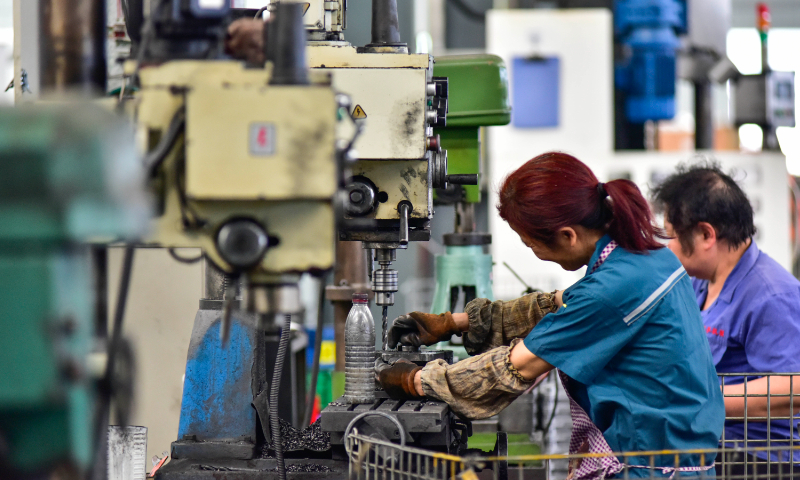
Workers process products at a workshop in Weifang, East China's Shandong Province, on June 9, 2023. Photo: VCG
China's consumer prices stayed flat in June on a yearly basis, maintaining the markedly low inflation trend, while the factory-gate prices of bulk commodities fell further to a record low since 2016, latest official data showed.
Although the weak price data since the start of the second quarter has aroused market concerns about a deflation that could harm the economic recovery of the world's second largest economy, experts said there are no deflation risks for the full year as the consumer prices are expected to rise in the third quarter with more policy stimulus to be rolled out to reinvigorate consumption activities.
China's consumer price index (CPI), a main gauge of inflation, came in flat in June year-on-year, and lower than the 0.2 percent increase in May, the National Bureau of Statistics (NBS) said on Monday.
Food prices rose 2.3 percent from a year earlier while prices of non-food items edged down 0.6 percent year-on-year.
The price of pork tumbled by 7.2 percent year-on-year, after dropping by 3 percent in May, offsetting the increase of prices of fresh vegetables, tuber crops, fruits and poultry meat, which increased by 4.3-10.8 percent, thus driving a decline in the CPI in June.
Among the non-food items, prices of services went up 0.7 percent in June, down 0.2 percentage points when compared with that of the previous month.
"There are multiple contributing factors, but the slowdown of services recovery is mainly due to residents' cautious approach in terms of consumption," Wu Chaoming, a deputy head of the Chasing Research Institute, told the Global Times on Monday.
With the supply end remaining stable, the country's CPI, in particular the core CPI which excludes the volatile food and energy prices, is showing a weak trend, reflecting the mild growth pace of the consumption end, said Wang Qing, chief macroeconomic analyst at Golden Credit Rating International.
Core CPI, which excludes food and energy prices, narrowed 0.2 percentage points to 0.4 percent in June, according to analysts' calculation.
"It is estimated that with more stimulus policies in the pipeline, consumption will gain recovery in the third quarter, driving up the core CPI," Wang told the Global Times on Monday, adding that the full-year CPI could return to the normal level of around 2 percent growth by the year end.
It is expected that the CPI will bottom out year-on-year in July, and then will enter the recovery phase, Wu said, noting that "the full year has no risk of deflation."
Fu Linghui, a spokesperson for the NBS, said previously that there are multiple reasons for the weak CPI including complex and severe international environment, sluggish world economy, insufficient domestic demand and a relatively high base of the same period last year. He stressed the weakness is temporary.
In the next stage, as Chinese economy continues to recover, the employment situation will gradually improve, and the growth of residents' income will accelerate, which will help expand consumption and lead to a rebound in CPI growth," Fu said.
The services industry, which accounts for 60 percent of the core CPI, still has large room to grow, Wu said, citing the robust demand for services in the post-COVID period.
China's Caixin services purchasing managers' index, a private gauge of the country's services sector, stood at 53.9 in June, down 3.2 points from the previous month but remaining in the expansion territory for a sixth straight month.
Along with the CPI, the NBS released June's producers price index (PPI), a main gauge of factory price, which showed a year-on-year decline of 5.4 percent, a record low since 2016.
"PPI's decline is mainly linked to the edging down of bulk commodity prices such as oil and coal, coupled with a high comparison base last year," NBS statistician said on Monday.
Wang estimated the PPI in June has bottomed out, and will see an increase in the remainder of the year with the high base effect of last year weakening and domestic economic momentum driving up the prices of upstream raw materials.
China has sent a clear signal that it is determined to spur the still unfolding economic recovery and unleash the growth potential amid multiple downward pressures ranging from a complex global geopolitical situation to weakening world demand.
To boost consumption, Wu suggested that relevant policies should focus on the low-income group in order to enhance their purchase power and willingness.
In terms of fiscal policies, Wang said it is possible that the issuance of new local government special bonds will speed up in the third quarter, and strengthen policy support for new-energy vehicles, green home appliances and household consumption and enhance the issuance of consumer coupons and consumption subsidies in various regions.
For the monetary policy, experts said the possibility of further cutting policy interest rates or reserve requirement ratio for banks should not be ruled out.
Last month, the People's Bank of China, the country's central bank, cut the benchmark lending rate loan prime rate in line with market expectations, ending nine months of continuity. It was the third effort to bring down the nation's policy rates within a week.




